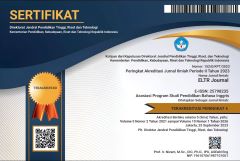PROCESS APPROACH AND COLLABORATIVE LEARNING ANALYSIS ON STUDENTS’ ACADEMIC WRITING
Abstrak terlihat: 876 / PDF terunduh: 673DOI:
https://doi.org/10.37147/eltr.v5i1.89Keywords:
collaborative learning, EFL, process approach, writing centerAbstract
Writing as a productive skill in English has been valued greatly, especially in an academic context. The process approach was started to be considered when teaching writing as it offers more meaningful learning. Furthermore, the approach makes room for collaborative learning between students and teachers. For EFL students whose first language is not English, mastering writing skills could be more challenging. To address the issues, the idea of a writing center has been adapted to a higher educational level for students who want to improve their writing. The study was conducted by using a qualitative descriptive approach and its data collection was carried out through a number of instruments to fulfill the triangulation method of a qualitative approach such as observation, semi-structured interviews, surveys, and corpus-based research. From the eight purposive sampling of tutees and the four tutors, the study concluded that EFL students are not familiar with the process of writing, so many of them consider having support merely on revising their essay draft. Even though collaborative writing was successfully carried out, but EFL students need to improve their independent study to follow up on the discussion they had with the tutors.
Downloads
References
Abas, I., & Abd Aziz, N. H. (2016). Indonesian EFL Students’ Perspective on
Writing Process: A Pilot Study (Vol. 7). https://doi.org/10.7575/aiac.alls.v.7n.3p.21
Al Fadda, H. (2012). Difficulties in Academic Writing: From the Perspective of King
Saud University Postgraduate Students. English Language Teaching, 5(3).
https://doi.org/10.5539/elt.v5n3p123
An Introduction to Higher Education Writing Centres_2.pdf. (n.d.). Retrieved from
https://www.maynoothuniversity.ie/sites/default/files/assets/document/An%20
Introduction%20to%20Higher%20Education%20Writing%20Centres_2.pdf
Ariyanti, A. (2016). The Teaching of EFL Writing in Indonesia. Dinamika Ilmu,
(2), 263. https://doi.org/10.21093/di.v16i2.274
Arrand, K. (2014). Peer tutoring. Journal of Pedagogic Development, 4(1).
Barnett, R. W., & Blumner, J. S. (1999). Writing Centers and Writing Across the
Curriculum Programs: Building Interdisciplinary Partnerships. Greenwood
Publishing Group.
Bitchener, J., Young, S., & Cameron, D. (2005). The effect of different types of
corrective feedback on ESL student writing. Journal of Second Language
Writing, 14(3), 191–205. https://doi.org/10.1016/j.jslw.2005.08.001
Bruffee, K. A. (1984). Collaborative Learning and the “Conversation of Mankind.”
College English, 46(7), 635. https://doi.org/10.2307/376924
Cahyono, B. Y. (2004). Research studies in second language writing and in
contrastive rhetoric. K@ Ta, 3(1), 39–52.
Chokwe, J. M. (2015). Students’ and tutors’ perceptions of feedback on academic
essays in an open and distance learning context. Open Praxis, 7(1).
https://doi.org/10.5944/openpraxis.7.1.154
Creswell, J. W. (2012). Educational research: planning, conducting, and evaluating
quantitative and qualitative research (4th ed). Boston: Pearson.
Dillenbourg, P. (1999). What do you mean by collaborative learning? Oxford:
Elsevier.
Eodice, M. (2005). Centers Association, which is an Affiliate of the National Council
of Teachers of.
Faraj, A. K. A. (2015). Scaffolding EFL Students’ Writing through the Writing
Process Approach. Journal of Education and Practice, 6(13), 131–141.
Giridharan, B., & Robson, A. (2011). Identifying gaps in academic writing of ESL
students. In Enhancing Learning: Teaching and learning conference 2011
proceedings. Enhancing Learning: Teaching and Learning Conference 2011,
Curtin University Sarawak.
Harris, M. (1995). Talking in the Middle: Why Writers Need Writing Tutors. College
English, 57(1), 27. https://doi.org/10.2307/378348
Javed, M., Juan, W. X., & Nazli, S. (2013). A Study of Students’ Assessment in
Writing Skills of the English Language. Online Submission, 6(2), 129–144.
Kim, H., Sefcik, J. S., & Bradway, C. (2017). Characteristics of Qualitative
Descriptive Studies: A Systematic Review. Research in Nursing & Health,
(1), 23–42. https://doi.org/10.1002/nur.21768
Moussu, L. (2013). Let’s talk! ESL students’ needs and writing centre philosophy.
TESL Canada Journal, 30(2), 55.
Mukminin, A., Ali, R. M., & Ashari, M. J. F. (2015). Voices from within: Student
teachers’ experiences in English academic writing socialization at one
Indonesian teacher training program. The Qualitative Report, 20(9), 1394
Mutimani, M. M. (2016). Academic writing in English: challenges experienced by
Bachelor of Education primary level students at the University of Namibia,
Katima Mulilo campus (PhD Thesis). University of Namibia.
Nation, P. (2007). The Four Strands. Innovation in Language Learning and Teaching,
(1), 2–13. https://doi.org/10.2167/illt039.0
Nordlof, J. (2014). Vygotsky, scaffolding, and the role of theory in writing center
work. The Writing Center Journal, 45–64.
North, S. M. (1982). Training Tutors to Talk about Writing. College Composition and
Communication, 33(4), 434. https://doi.org/10.2307/357958
North, S. M. (1984). The Idea of a Writing Center. College English, 46(5), 433.
https://doi.org/10.2307/377047
Onozawa, C. (2010). A study of the process writing approach: A suggestion for an
eclectic writing approach.
Pemberton, M. A., & Kinkead, J. A. (Eds.). (2003). The center will hold: critical
perspectives on writing center scholarship. Logan: Utah State University
Press.
Puntambekar, S., & Hubscher, R. (2005). Tools for scaffolding students in a complex
learning environment: What have we gained and what have we missed?
Educational Psychologist, 40(1), 1–12.
Qualitative descriptive research: An acceptable design. (n.d.). Retrieved March 17,
, from
https://www.researchgate.net/publication/284943786_Qualitative_descriptive
_research_An_acceptable_design
Riedner, R., O’Sullivan, Í., & Farrell, A. (2015). An introduction to writing in the
disciplines (WID) curriculum, AISHE practice guide 5.
Robinson, H. M. (2009). Writing center philosophy and the end of basic writing:
Motivation at the site of remediation and discovery. Journal of Basic Writing,
–92.
Thonus, T. (2003). Serving generation 1.5 learners in the university writing center.
TESOL Journal, 12(1), 17–24.
Van Boxtel, C., Van der Linden, J., & Kanselaar, G. (2000). Collaborative learning
tasks and the elaboration of conceptual knowledge. Learning and Instruction,
(4), 311–330.
Zhou, D. (2015). An Empirical Study on the Application of Process Approach in
Non-English Majors’ Writing. English Language Teaching, 8(3).
Downloads
Published
How to Cite
Issue
Section
License
Copyright (c) 2021 Christianus I Wayan Eka Budiartha

This work is licensed under a Creative Commons Attribution-ShareAlike 4.0 International License.













